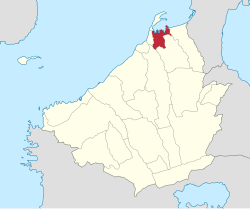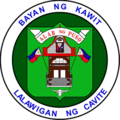Kawit
Municipality in Cavite, Philippines From Wikipedia, the free encyclopedia
Kawit, officially the Municipality of Kawit (Tagalog: Bayan ng Kawit), is an urban municipality in the province of Cavite, Philippines. According to the 2020 census, it has a population of 107,535.[3] It is one of the notable places that had a major role in the country's history during the 1800s and 1900s.
This article needs additional citations for verification. (October 2013) |
Kawit
Cavite el Viejo | |
|---|---|
| Municipality of Kawit | |
 | |
| Nickname(s): Site of the Declaration of Independence, Flag Town of the Republic | |
| Motto(s): Alab ng Puso (Flaming Heart) | |
 Map of Cavite with Kawit highlighted | |
Location within the Philippines | |
| Coordinates: 14°26′N 120°54′E | |
| Country | Philippines |
| Region | Calabarzon |
| Province | Cavite |
| District | 1st district |
| Founded | 1587 or August 1, 1600 |
| Renamed | September 20, 1907 (as Kawit) |
| Barangays | 23 (see Barangays) |
| Government | |
| • Type | Sangguniang Bayan |
| • Mayor | Angelo Emilio G. Aguinaldo |
| • Vice Mayor | Edward R. Samala Jr. |
| • Representative | Ramon Revilla III |
| • Municipal Council | Members |
| • Electorate | 69,598 voters (2025) |
| Area | |
• Total | 25.15 km2 (9.71 sq mi) |
| Elevation | 6.0 m (19.7 ft) |
| Highest elevation | 47 m (154 ft) |
| Lowest elevation | 0 m (0 ft) |
| Population (2020 census)[3] | |
• Total | 107,535 |
| • Density | 4,300/km2 (11,000/sq mi) |
| • Households | 29,082 |
| Demonym | Kawiteño |
| Economy | |
| • Income class | 1st municipal income class |
| • Poverty incidence | 10.13 |
| • Revenue | ₱ 546.8 million (2022) |
| • Assets | ₱ 851.9 million (2022) |
| • Expenditure | ₱ 630.3 million (2022) |
| • Liabilities | ₱ 404.3 million (2022) |
| Service provider | |
| • Electricity | Manila Electric Company (Meralco) |
| Time zone | UTC+8 (PST) |
| ZIP code | 4104 |
| PSGC | |
| IDD : area code | +63 (0)46 |
| Native languages | Tagalog |
| Major religions | Catholic |
| Catholic diocese | Roman Catholic Diocese of Imus |
| Patron saint | St. Mary Magdalene |
Formerly known as Cavite el Viejo, it is the location of his home, and the name Kawit is from the word kalawit, the Aguinaldo Shrine, where independence from Spain was declared on June 12, 1898. It is also the birthplace of Emilio Aguinaldo, the first president of the Philippines, who from 1895 to 1897, served as the municipality's chief executive.
Kawit is 13 kilometres (8.1 mi) from Imus and 23 kilometres (14 mi) from Manila.
Etymology
The name Kawit is derived from the Tagalog word kawit or kalawit (hook), which is suggestive of its location at the base of a hook-shaped shoreline along Manila Bay extending to the tip of Cavite City.
Legend, however, gives another version on how the town got its name. One day, a Spanish visitor asked a native blacksmith about the name of the village. The latter was busy at the time pounding on the anvil a piece of hot metal that looked like a hook. He hesitated to speak, not understanding what the stranger was asking, but when pressed for an answer, and thinking that he wanted to know what he was doing, he merely said kawit. The Spanish left muttering the word kawit. In the course of the time, the word evolved into cauite, and finally cavite.
History
Summarize
Perspective

Kawit was the most thriving settlement prior to the coming of the Spanish. In fact, the town provided the first anchorage of the Spanish in the province, whence colonization and proselytization of the Christian religion began, spreading to all corners of the province. It was established as a town in 1587 or, as recognized by laws, on August 1, 1600.[5][6]
For a long time, the place was called by the Spanish "Cavite el Viejo" or Old Cavite to distinguish it from "Cavite la Punta" or "Cavite el Puerto", the commercial port and naval base (now Cavite City) whence came many Spanish marines on shore leave who made frequent visits to Cavite el Viejo, eventually turning it into a red-light district. This seedy reputation of the town was erased when Saint Mary Magdalene was made patroness, under the spiritual supervision of the Jesuits as ordered by Miguel García Serrano, O.S.A. (1618–1629), the fifth Archbishop of Manila.
With the establishment in the wake of the Philippine Revolution, the Philippine Independent Church built a shrine to Saint Michael, the Archangel in the barrio of Binakayan in 1902.
Cavite el Viejo was then a big town, comprising the municipality of Kawit today, Cavite la Punta (now Cavite City), Noveleta (called Tierra Alta by the Spanish), and Imus. Eventually, these three barrios' populations grew and they eventually seceded to become independent municipalities.
Aside from its role as the birthplace of independence, Kawit was also the site of the Battle of Binakayan-Dalahican, one of several Filipino victories during the Revolution.
In 1907, the town was renamed to Kawit, its present name, by virtue of Act No. 1718 by the Philippine Commission.[7]
Geography
Barangays
Kawit is politically subdivided into 23 barangays, as indicated below. [8] Each barangay consists of puroks and some have sitios.
- Balsahan-Bisita
- Batong Dalig
- Binakayan-Aplaya
- Binakayan-Kanluran
- Congbalay-Legaspi
- Gahak
- Kaingen
- Magdalo (Putol)
- Manggahan-Lawin
- Marulas
- Panamitan
- Poblacion
- Pulvorista/Polvorista
- Samala-Marquez
- San Sebastian
- Santa Isabel
- Tabon I
- Tabon II
- Tabon III
- Toclong (Different from Toclong in neighboring Imus)
- Tramo-Bantayan
- Wakas I
- Wakas II
Climate
| Climate data for Kawit, Cavite | |||||||||||||
|---|---|---|---|---|---|---|---|---|---|---|---|---|---|
| Month | Jan | Feb | Mar | Apr | May | Jun | Jul | Aug | Sep | Oct | Nov | Dec | Year |
| Mean daily maximum °C (°F) | 29 (84) |
30 (86) |
32 (90) |
34 (93) |
32 (90) |
31 (88) |
29 (84) |
29 (84) |
29 (84) |
30 (86) |
30 (86) |
29 (84) |
30 (87) |
| Mean daily minimum °C (°F) | 21 (70) |
20 (68) |
21 (70) |
22 (72) |
24 (75) |
25 (77) |
24 (75) |
24 (75) |
24 (75) |
23 (73) |
22 (72) |
21 (70) |
23 (73) |
| Average precipitation mm (inches) | 10 (0.4) |
10 (0.4) |
12 (0.5) |
27 (1.1) |
94 (3.7) |
153 (6.0) |
206 (8.1) |
190 (7.5) |
179 (7.0) |
120 (4.7) |
54 (2.1) |
39 (1.5) |
1,094 (43) |
| Average rainy days | 5.2 | 4.5 | 6.4 | 9.2 | 19.7 | 24.3 | 26.9 | 25.7 | 24.4 | 21.0 | 12.9 | 9.1 | 189.3 |
| Source: Meteoblue[9] | |||||||||||||
Demographics
This section needs expansion. You can help by adding to it. (December 2023) |

| Year | Pop. | ±% p.a. |
|---|---|---|
| 1903 | 6,114 | — |
| 1918 | 6,855 | +0.77% |
| 1939 | 10,783 | +2.18% |
| 1948 | 13,970 | +2.92% |
| 1960 | 19,352 | +2.75% |
| 1970 | 28,447 | +3.92% |
| 1975 | 33,813 | +3.53% |
| 1980 | 39,368 | +3.09% |
| 1990 | 47,755 | +1.95% |
| 1995 | 56,993 | +3.37% |
| 2000 | 62,751 | +2.08% |
| 2007 | 76,405 | +2.75% |
| 2010 | 78,209 | +0.85% |
| 2015 | 83,466 | +1.25% |
| 2020 | 107,535 | +5.11% |
| Source: Philippine Statistics Authority[10][11][12][13] | ||
In the 2020 census, the population of Kawit was 107,535 people,[3] with a density of 4,700 inhabitants per square kilometer or 12,000 inhabitants per square mile.
Economy
This section needs expansion. You can help by adding to it. (December 2023) |

Poverty incidence of Kawit
2.5
5
7.5
10
12.5
15
2000
10.05 2003
6.66 2006
5.80 2009
4.79 2012
5.88 2015
9.51 2018
5.66 2021
10.13 Source: Philippine Statistics Authority[14][15][16][17][18][19][20][21] |
Culture
Maytinis Festival
An original Kawit tradition that takes place every Christmas Eve, a dramatic retelling of the Virgin Mary and Joseph's search in Bethlehem for a place to stay called "Panunuluyan". This reenactment happens on the streets of Kawit with different floats depicting different biblical scenes from Adam and Eve up to Mary and Joseph. The "Panunuluyan" takes place in several houses and is done in singing until it reaches the 400-year-old St. Mary Magdalene Church, where the Virgin Mary and Joseph are welcomed by angels in a giant belen (Nativity Scene), which covers the whole main Retablo or altarpiece of the church. The songs performed by the angels acted by little girls are mostly in Spanish and Tagalog.
Government

Local government
Like any other Philippine municipality, Kawit is headed by a municipal mayor, vice mayor, and 10 councilors, eight of them elected at large by the voting populace and two of them being sectoral representatives (one for the barangays and one for the youth, elected respectively through their federations).
The mayor is assisted by the vice mayor, who presides over a legislative council. The current mayor of the historical town is Angelo Emilio G. Aguinaldo, a descendant of the first officially recognized President of the Philippines, General Emilio Aguinaldo. The current vice mayor is Edward R. Samala Jr.
Sister city
 Sakegawa, Yamagata, Japan[22]
Sakegawa, Yamagata, Japan[22]
Images
- Procession (Karakol, dancing)
- Emilio Aguinaldo tomb
- Old Town Hall facade
- Junction
- Beach
- Kawit Toll Plaza of Manila–Cavite Expressway (CAVITEX)
See also
References
External links
Wikiwand - on
Seamless Wikipedia browsing. On steroids.










